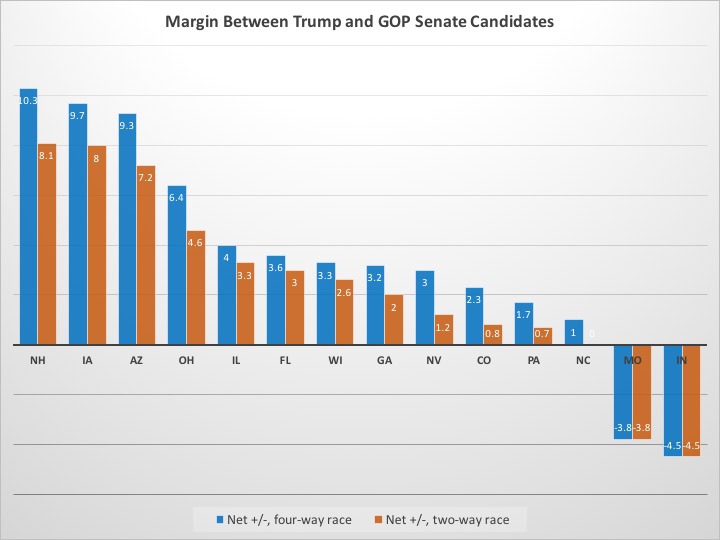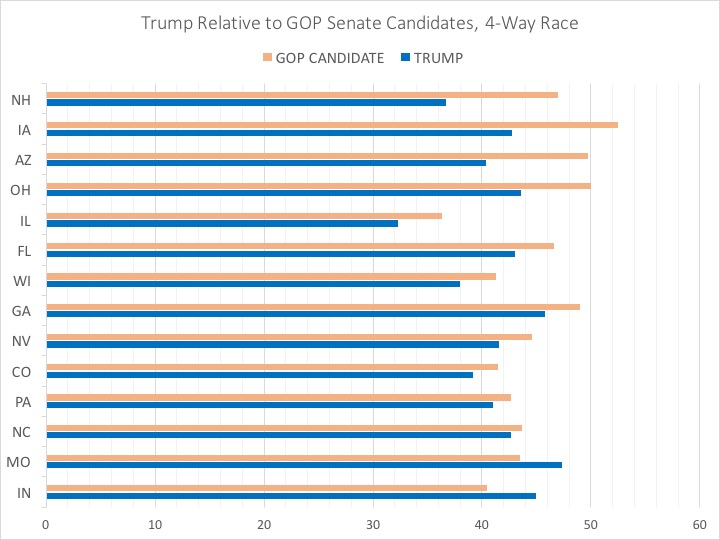A bit more than a month from Election Day, the electoral forecasts for Republicans differ between congressional campaigns and the one for the White House. The party’s odds of retaining the Senate, once believed long, have improved substantially in recent weeks, as one-time toss-up races like Florida and Ohio now favor the GOP. But Donald Trump’s chances of capturing the presidency are becoming increasingly endangered.
A comparison of how Republican Senate hopefuls are faring compared to the presidential nominee in crucial battlegrounds tells much of the story. In 12 of 14 showdowns for the upper chamber that Real Clear Politics identifies as “key” contests, the down-ballot GOP candidate is outperforming Trump in the polls. This accounts for Trump’s numbers in both two- and four-way fields in the run for the White House. (In only a couple of instances does the difference between the margins in the two- and four-way comparisons exceed two percentage points.)

In Nevada, North Carolina, and Pennsylvania—three of the tightest Senate elections and key swing states in the presidential fight—Trump and the Republican Senate contenders are tracking each other closely. But that’s not the case in every big race. Rob Portman, the Ohio senator once thought to be one of the most vulnerable GOP incumbents, is running about five or six points ahead of Trump—even as the latter has solidified a small lead over Hillary Clinton there. New Hampshire’s Kelly Ayotte has the most substantial margin above Trump, as high as 10 points when comparing her standing to that of Trump’s in the expanded Granite State field.

It’s easiest to infer how Trump might affect a Senate race considering an extreme polling example like the case of Ayotte. Trump has a -30-point favorable rating among likely voters in New Hampshire, making her dissociation from the presidential candidate obvious and moments like her fleeting, ungainly embrace of him Monday—in which she said Trump’s aspiration to be president is reason enough to call him some sort of a role model—all the more politically volatile. (She said she “misspoke” later that night.)
On the flip side of the margins between Trump and Senate hopefuls is a state like Indiana, where Trump is running more than four points ahead of Indiana representative and Evan Bayh challenger Todd Young. (Granted, neither Young’s nor the presidential race there have been polled much.) With only one exception in recent decades, the Hoosier state has been a reliable source of electoral votes for the GOP. It looks like Trump will win there easily this time, too—potentially lightening whatever drag he could have on Young, who has closed the gap with Bayh since August.
But on the whole, the takeaway of these survey margins is clear: Republicans have fretted that Trump could burden down-ballot candidates, and these numbers, when contextualized, can provide some evidence as to why. It’s thanks to the individual strength of some incumbents—Chuck Grassley (Iowa), John McCain (Arizona), Portman (Ohio), and Marco Rubio (Florida)—that not every race is affected the same.
In New Hampshire, Pennsylvania, North Carolina, and Nevada, though—swing states in the presidential contest that tilt toward Clinton as a group—the front yards of Republicans may be filled with as many yard signs as fingernails all the way through November 8.

